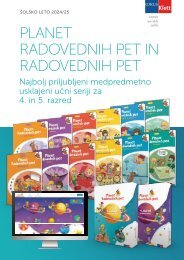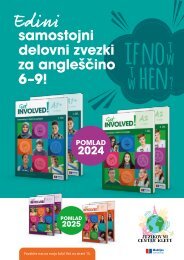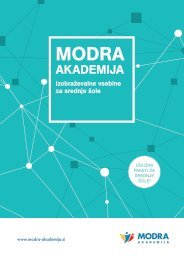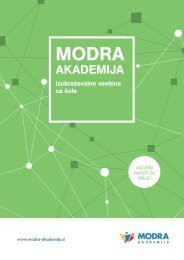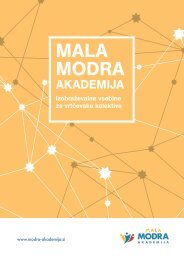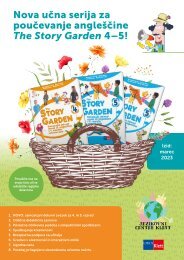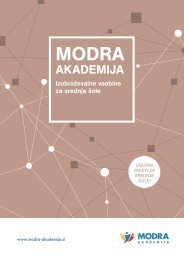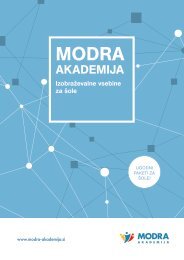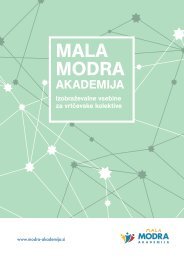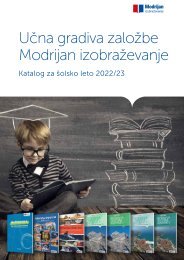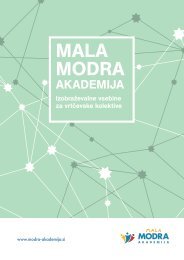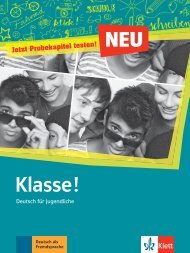Create successful ePaper yourself
Turn your PDF publications into a flip-book with our unique Google optimized e-Paper software.
NOVA SERIJA ZA ANGLEŠČINO<br />
<strong>Gateway</strong>2 nd Edition<br />
ZA GIMNAZIJE IN SREDNJE TEHNIŠKE<br />
TER STROKOVNE ŠOLE!<br />
NOVO!<br />
Najboljša izbira za uspeh na maturi!
Spoštovane profesorice,<br />
spoštovani profesorji,<br />
dovolite mi, da ta uvodnik začnem z besedami Davida<br />
Spencerja, avtorja naše nove učne serije <strong>Gateway</strong> 2 nd <strong>edition</strong>:<br />
»After studying Modern Languages, I trained to be<br />
a secondary school teacher. And I’m still teaching in<br />
a secondary school now, over 25 years later. Being in the<br />
classroom every day is a great help when writing a course like<br />
<strong>Gateway</strong>. On the other hand, the daily contact with teenagers<br />
gives me ideas and inspiration. On the other hand, it keeps<br />
me realistic about what actually works in the classroom.«<br />
V veselje mi je, da vam lahko s šolskim letom <strong>2020</strong>/21<br />
v založbi Modrijan izobraževanje ponudimo naš prvi<br />
učni komplet za poučevanje angleščine v srednjih šolah.<br />
Verjamemo, da <strong>Gateway</strong> 2 nd <strong>edition</strong> ni zgolj še ena izmed<br />
potrjenih učnih serij za srednje šole, ampak da prinaša<br />
natančno to, kar profesorji angleščine pri svojem pouku<br />
najbolj potrebujete in želite:<br />
Vocabulary and Reading<br />
The first exercise<br />
gives students the<br />
opportunity to test<br />
their prior knowledge<br />
by introducing topicrelated<br />
vocabulary.<br />
Vocabulary is brought<br />
to life with skills<br />
activities, allowing<br />
students to personalise<br />
the language.<br />
STUDENT‘S BOOK<br />
Reading tasks<br />
focus on<br />
stimulating topics<br />
using recognisable<br />
and relevant<br />
contexts.<br />
The Critical thinking<br />
activity embedded in<br />
every Reading lesson<br />
guides students towards<br />
the use of higherorder<br />
thinking skills. It<br />
also gives students the<br />
opportunity to develop<br />
analytical skills and use<br />
them in an authentically<br />
communicative way.<br />
• številna zanimiva in dovolj obsežna besedila,<br />
ki spodbujajo kritično razmišljanje, odprte debate<br />
in komunikacijo v razredu,<br />
• sistematično razvijanje in nadgrajevanje besedišča,<br />
• jasne razlage slovničnih pravil z nalogami različnih<br />
težavnosti, ki v razredu omogočajo diferenciacijo, ter<br />
• uporabne napotke za uspešno reševanje različnih tipov<br />
nalog.<br />
Typical reading tasks<br />
include exam-style<br />
comprehension<br />
questions such as<br />
multiple-choice, True/<br />
False or inserting<br />
sentences into a text.<br />
S tipologijo nalog, ki v največji mogoči meri ustreza tudi<br />
slovenski maturi, in z obsežnim naborom dodatnega<br />
materiala, ki je na spletni strani www.macmillangateway2.com<br />
na voljo tako za učitelja kot tudi za dijaka, je učni komplet<br />
<strong>Gateway</strong> 2 nd <strong>edition</strong> več kot odlična osnova za uspešne<br />
rezultate na maturi.<br />
Vabim vas, da v nadaljevanju spoznate nekaj ključnih odlik<br />
novega gradiva <strong>Gateway</strong> 2 nd <strong>edition</strong>, za dodatne informacije<br />
pa sem vam z veseljem na voljo prek spodnjih kontaktnih<br />
podatkov.<br />
Prijazen pozdrav!<br />
Marjeta Juvan,<br />
svetovalka za tujejezično literaturo<br />
marjeta.juvan@modrijan-izobrazevanje.si<br />
051 207 500<br />
The Flipped classroom<br />
grammar presentation<br />
video (A1+ – B2+)<br />
provides a versatile<br />
and flexible learning<br />
tool, and an alternative<br />
grammar presentation<br />
which gives students<br />
greater control over<br />
their learning.<br />
The Grammar guide<br />
box highlights sentences<br />
from the reading text.<br />
Students work out key<br />
information about the<br />
form and use of the<br />
grammar. They are then<br />
referred to the Grammar<br />
reference section in the<br />
Language checkpoint<br />
at the end of the unit to<br />
check their ideas.<br />
Grammar in context<br />
and Developing vocabulary<br />
The second vocabulary<br />
set in a unit is often not<br />
a traditional lexical set. It<br />
may examine a ‘system’<br />
of vocabulary and<br />
often bridges the gap<br />
between vocabulary and<br />
grammar.<br />
Students are given the<br />
opportunity to practise<br />
the language they have<br />
encountered in the<br />
activity.<br />
Students progress to<br />
controlled grammar<br />
practice.<br />
The final grammar<br />
activity asks students<br />
to use the new<br />
grammar in active, oral<br />
communication.<br />
3
Each unit has a Life<br />
skills lesson that<br />
allows students both<br />
controlled and freer<br />
language practice,<br />
using what they have<br />
learned in previous<br />
lessons in a cumulative<br />
way. <strong>Gateway</strong> to life<br />
skills lessons equip<br />
students with the<br />
necessary transferable<br />
skills for life beyond<br />
the classroom.<br />
<strong>Gateway</strong> to Life Skills<br />
The Developing<br />
speaking lesson<br />
develops students’<br />
oral skills with a<br />
highly structured<br />
and supportive<br />
approach to<br />
speaking.<br />
Developing speaking and<br />
Developing writing<br />
The Life skills lesson is<br />
introduced to students<br />
with clear objectives.<br />
Students have many<br />
opportunities to give and<br />
share their opinions.<br />
The Life skills lesson culminates in a productive Life task<br />
such as giving a presentation, creating a poster or making a<br />
plan. It gives students the opportunity to use language in an<br />
authentic and collaborative context while practising a useful<br />
and transferable Life skill.<br />
Students listen to<br />
a wide range of<br />
realistic recordings<br />
including dialogues,<br />
radio programmes,<br />
adverts and<br />
interviews.<br />
There is a wide<br />
variety of examtype<br />
listening tasks,<br />
such as True/False,<br />
completing notes<br />
and matching.<br />
Listening and Grammar<br />
in context<br />
The second Grammar in context lesson<br />
functions in the same way as the previous<br />
one allowing students to discover<br />
grammar rules for themselves.<br />
The engaging videos (A1+ – B2+)<br />
present a mixture of real teenagers and<br />
subject experts talking about the Life<br />
skills topics in the form of interviews,<br />
presentations and vlogs.<br />
Students are given lots of opportunities to use<br />
new grammar in active, oral communication.<br />
This activity usually involves personalisation.<br />
Students work in pairs or small groups and<br />
find out new things about their classmates.<br />
The Speaking<br />
bank highlights<br />
and analyses<br />
key language for<br />
students to refer<br />
to during the<br />
productive phase of<br />
the speaking task.<br />
There are two Exam success boxes in each unit. They ask<br />
students to reflect on the best way to carry out a specific<br />
exam task. Students can discuss the question in pairs and<br />
they are then directed to a special section at the end of the<br />
book where useful strategies and tips are explained.<br />
Language checkpoint<br />
The Grammar<br />
reference at<br />
the end of each<br />
unit enables<br />
students to<br />
revise for tests<br />
more easily, and<br />
consolidates<br />
what they have<br />
studied.<br />
A checklist<br />
of the main<br />
vocabulary<br />
in the unit is<br />
followed by a<br />
reference to<br />
the wordlist at<br />
the back of the<br />
book which<br />
contains all the<br />
new words and<br />
phrases that<br />
appear in the<br />
unit.<br />
Students are given help in<br />
planning and organising the<br />
information they need to<br />
use in their writing activities.<br />
Model texts give students<br />
realistic examples of different<br />
genres of written texts.<br />
The Writing bank highlights and<br />
analyses the key language of<br />
the writing task and gives help<br />
in planning and organising the<br />
information they need to include.<br />
Students refer to it during the<br />
productive stage.<br />
Each unit has<br />
a Language<br />
checkpoint<br />
with tables and<br />
explanations for<br />
quick reference or<br />
deeper reflection.<br />
Teachers and<br />
students can test<br />
progress by using<br />
the exercises on<br />
the revision page<br />
opposite the<br />
reference page.<br />
The revision section<br />
includes marking<br />
points to help track<br />
where more work<br />
may be needed.<br />
Vocabulary revision section<br />
can be used for self-study as<br />
well as in class.
Every two units<br />
the <strong>Gateway</strong> to<br />
exams pages allow<br />
students to test their<br />
progress and at the<br />
same time develop<br />
their skills through<br />
targeted training<br />
tasks for exams.<br />
Students are referred to the Exam success<br />
pages at the back of the book for more<br />
detailed exploration of the skills they have<br />
been learning and the best way to approach a<br />
specific exam task.<br />
The ‘Can do’ progress check empowers students by<br />
encouraging them to measure their own progress<br />
against a checklist of tasks they are able to do<br />
successfully after every two units. It also acts as a useful<br />
summary of the language topics and skills covered so far.<br />
Life Skills videos<br />
The Life skills videos form part of the Life skills lessons. They show British<br />
teens demonstrating or discussing the Life skills topic in a way that has<br />
direct relevance to all students’ lives. There are comprehension tasks on<br />
the Student’s Book page and further exploitation exercises and activities<br />
for the video in the Resource Centre.<br />
Useful exam tips<br />
cover all of the<br />
skills – Writing,<br />
Speaking, Listening<br />
and Reading – give<br />
guidance for Use<br />
of English tasks,<br />
providing invaluable<br />
reminders and<br />
hints for students<br />
to approach<br />
their exams fully<br />
prepared.<br />
By presenting the<br />
grammar to students<br />
outside class time, the<br />
Flipped classroom<br />
approach allows for more<br />
lesson-time practice.<br />
<strong>Gateway</strong> to Exams<br />
The videos are a versatile<br />
and efficient resource<br />
for teachers, since they<br />
can be used flexibly for<br />
mixed-ability groups or<br />
for revision.<br />
The Flipped classroom videos, delivered by <strong>Gateway</strong><br />
<strong>2nd</strong> Edition author, David Spencer, offer an engaging<br />
grammar presentation of each unit’s Grammar in<br />
context section. The visual presentations introduce<br />
concepts and make new structures accessible<br />
through examples, timelines and diagrams.<br />
2Content-based material<br />
and critical thinking<br />
1Preparation for<br />
school-leaving exams<br />
The video formats are fun<br />
and appeal to teens and feature:<br />
• vlogs<br />
• school projects<br />
• street interviews<br />
• role-plays<br />
• interviews<br />
8Developing<br />
skills<br />
The Flipped classroom<br />
refers to students<br />
learning new content<br />
outside the classroom,<br />
via video presentations,<br />
and then doing practice<br />
in the class. This makes it<br />
easier for the teacher to<br />
give more personalised<br />
help and attention during<br />
the practice stage. It also<br />
means students can go<br />
at their own speed during<br />
the presentation stage.<br />
Flipped classroom<br />
3Life skills<br />
4The active role<br />
of the learner<br />
8reasons<br />
to choose<br />
<strong>Gateway</strong><br />
5Grammar<br />
in context<br />
7Developing<br />
vocabulary<br />
6The Flipped<br />
classroom<br />
7
WORKBOOK<br />
TEACHER‘S BOOK<br />
PREMIUM PACK<br />
Exercises support the Student’s Book and<br />
give extra practice in developing vocabulary,<br />
often through the use of images, puzzles and<br />
other engaging tasks.<br />
Vocabulary extension boxes expand on<br />
the vocabulary taught in the Student’s<br />
Book, offering students more challenge.<br />
Cumulative Grammar challenge boxes<br />
provide students with more demanding<br />
practice of the target language. These<br />
activities are particularly valuable in mixedability<br />
classes.<br />
Includes:<br />
• Presentation kit<br />
• Digital student‘s book<br />
• Online workbook<br />
• Test generator<br />
• Flipped classroom videos<br />
• Life skills videos<br />
• Macmillan readers ebook<br />
• Audio<br />
• Resource centres<br />
Past simple<br />
Part 1: Video preparation<br />
a b<br />
c<br />
Flipped classroom Unit<br />
Flipped classroom Unit<br />
some, any, much, many, a lot of, a few,<br />
a little<br />
Part 1: Video preparation<br />
1 Do you remember reading about mapping the<br />
world’s languages on page 33 of your Student’s<br />
Book? Look at the photos. What do the colours<br />
show in the map?<br />
London?<br />
2 Name three languages used in North America.<br />
3 What is unusual or surprising about the tweets in<br />
Part 2: Video comprehension<br />
1 Do you remember reading the stories on page 19<br />
Watch the video as many times as necessary and do<br />
the exercises.<br />
of your Student’s Book? In the stories, (a) which<br />
of these things happen, (b) which possibly<br />
happens and (c) which does not happen?<br />
1 an art theft<br />
2 a bank robbery<br />
3 the arrest of<br />
thieves<br />
1 Answer the questions.<br />
1 Name three examples of countable nouns used in<br />
the examples about quantities.<br />
2 Complete these words and phrases from the text<br />
with vowels.<br />
1 s t d s t l l<br />
2 Name two examples of uncountable nouns used in<br />
the examples about quantities.<br />
3 c r m n l s<br />
2 p r t n d d 4 s h p d s p l y<br />
Part 2: Video comprehension<br />
3 Do you think the presenter (Dave) has any problems?<br />
4 Do you think the presenter (Dave) has got a few<br />
sports cars?<br />
Watch the video as many times as necessary and do<br />
the exercises.<br />
1 Answer the questions.<br />
1 Look at the picture. Which of these three<br />
pictures (a–c) does the presenter (Dave)<br />
talk about?<br />
2 Complete each rule with the correct words from<br />
the video explanation.<br />
2 When did the police see the robbers?<br />
a We use and to describe<br />
quantities in general.<br />
b We use and to talk<br />
about small quantities.<br />
c We use , and<br />
to talk about big quantities.<br />
d We use to say that we<br />
have none.<br />
3 Where is the presenter (Dave) now? What about<br />
last week?<br />
4 Does the presenter (Dave) think that the joke at the<br />
end of the video is good?<br />
3 Look at the sentences. Tick (✓) the one that does<br />
NOT appear in the video explanation.<br />
2 Complete the rule with the correct word from the<br />
video explanation.<br />
1 I’ve got a little water.<br />
2 We’ve got some books.<br />
3 I haven’t got many maps.<br />
4 I’ve got a few sports cars.<br />
5 Have you got any plans?<br />
6 I haven’t got much water.<br />
We use the past simple to describe<br />
actions or situations in the past.<br />
3 Tick (✓) the sentences or questions that appear in<br />
the video.<br />
1 The police arrested them.<br />
4 Circle the correct alternative to complete each<br />
2 The thieves didn’t stand still.<br />
3 Did the police see them?<br />
4 They were at school last week.<br />
5 He wasn’t in class last week.<br />
6 Was it a disaster?<br />
rule (1–5) from the video explanation.<br />
1 We use some/any and a lot of with uncountable<br />
nouns and plural countable nouns in affirmative<br />
sentences.<br />
2 We use some/any and a lot of with uncountable<br />
nouns and plural countable nouns in negative<br />
sentences and questions.<br />
3 We often use much/many with uncountable nouns in<br />
negative sentences and questions.<br />
4 We often use much/many with plural countable<br />
nouns in negative sentences and questions.<br />
5 We use a few/a little with plural countable nouns<br />
and a few/a little with uncountable nouns.<br />
4 Read the rules for the past simple. One rule is<br />
incomplete. Watch the video and then complete<br />
that rule.<br />
1 Regular verbs in the past simple finish in -ed.<br />
2 We form negative sentences with didn’t +<br />
the main verb.<br />
3 Question forms for most verbs in the past simple<br />
follow the pattern: + subject.<br />
Part 3: Grammar practice<br />
4 The past simple of the verb to be is was/were.<br />
Part 3: Grammar practice<br />
B1<br />
Complete the sentences with these words. Use the<br />
words once only.<br />
Rewrite the sentences according to the instructions<br />
in brackets.<br />
a few • a little • any • many • much • some<br />
1 Are there areas of your country where<br />
they speak a different language?<br />
2 I haven’t got time to finish the exam.<br />
Only ten minutes!<br />
3 There aren’t colours to choose from.<br />
Only yellow and orange.<br />
4 We only have juice. There isn’t a lot.<br />
5 I can understand French but I can’t speak<br />
it very well.<br />
6 He’s travelling around countries in<br />
Europe – Denmark, Sweden and Germany.<br />
1 The work of art was a bottle of milk. (negative)<br />
2 An art thief took it. (question)<br />
B1<br />
3 Oliver didn’t disappear. (affirmative)<br />
4 The banks weren’t open on Saturday afternoon.<br />
(question)<br />
5 Did they see the computers in the bank? (affirmative)<br />
This page has been downloaded from www.macmi langateway2.com<br />
© Macmillan Publishers Limited 2016. This sheet may be photocopied and used within class.<br />
This page has been downloaded from www.macmi langateway2.com<br />
© Macmillan Publishers Limited 2016. This sheet may be photocopied and used within class.<br />
1 of 1<br />
2 of 10<br />
1 of 1<br />
3 of 10<br />
Listening tasks recycle the vocabulary of<br />
the unit. The task types match those in<br />
the Student’s Book, giving students further<br />
opportunity to develop particular exam<br />
skills.<br />
Student’s Resource Centre<br />
The Student’s Resource Centre provides complementary materials<br />
to consolidate learning and encourage independent study including:<br />
■ Teen-focused culture worksheets to inspire a broader<br />
cultural perspective. Available in A1+ – B2+<br />
■ A graded Macmillan Reader, with extra activities and<br />
extended reading support. Available in A1+ – B2+<br />
■ Study skills materials to encourage students to take<br />
control of their learning<br />
Teacher’s Resource Centre<br />
The Teacher’s Resource Centre is your go-to place for resources to deliver dynamic<br />
lessons in the classroom, for homework assignments and to support you in the<br />
classroom. The flexible content includes:<br />
■ Life skills video worksheets and Flipped classroom video<br />
worksheets to support students in getting the most out of<br />
the video material. Available in A1+ – B2+<br />
■ Audio and video files and scripts<br />
Cumulative revision pages provide<br />
essential recycling of language from not<br />
only the preceding unit but also earlier<br />
units in the book.<br />
■ Complete answer keys<br />
■ Teacher tips and videos<br />
■ Extra grammar worksheets and communication activities<br />
■ Everyday English worksheets<br />
■ Optional CLIL and literature lessons. Available in A1+ – B2+<br />
■ Teacher notes and guides to accompany all material<br />
8 9
ZA GIMNAZIJE<br />
IN SREDNJE TEHNIŠKE TER<br />
STROKOVNE ŠOLE!<br />
KOMPONENTE: B1+ B2 B2+<br />
Student‘s Book Pack<br />
(Student’s Book + Student’s Book<br />
Resource Centre)<br />
9780230473140 9780230473188 9780230473218<br />
Workbook 9780230470941 9780230470972 9780230471009<br />
Teacher’s Book Premium Pack 9780230473164 9780230473195 9780230473225<br />
NAROČANJE:<br />
narocila@modrijan-izobrazevanje.si<br />
DODATNE INFORMACIJE IN SVETOVANJE:<br />
Marjeta Juvan, svetovalka za tujejezično literaturo<br />
marjeta.juvan@modrijan-izobrazevanje.si<br />
051 207 500<br />
Modrijan izobraževanje, d. o. o.<br />
Stegne 9 b, 1000 Ljubljana<br />
www.modrijan-izobrazevanje.si<br />
Na naslovu osebni.podatki@modrijan-izobraževanje.si ali Modrijan izobraževanje, d. o. o., OSEBNI PODATKI, Stegne 9 b, 1000 Ljubljana<br />
lahko kadarkoli pisno zahtevate, da trajno ali začasno prenehamo uporabljati vaše osebne podatke za namene neposrednega trženja.




